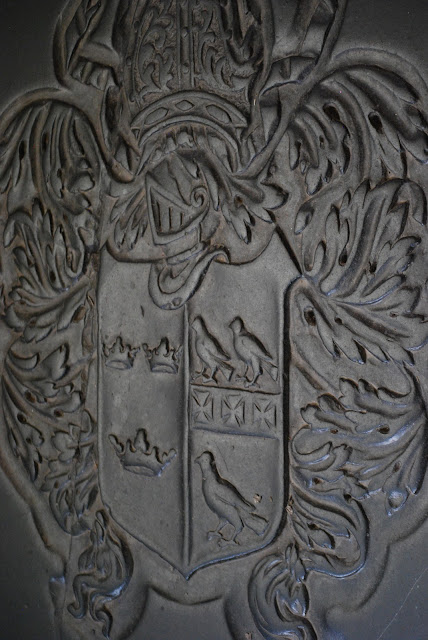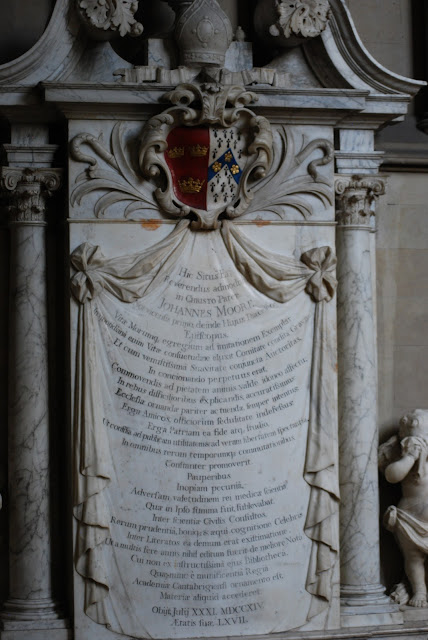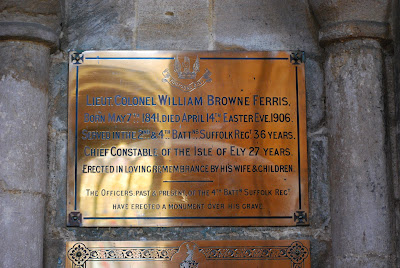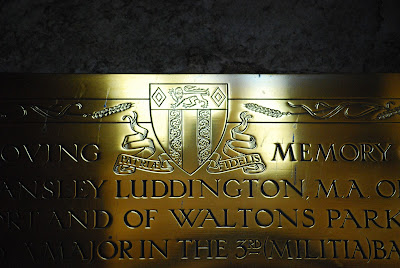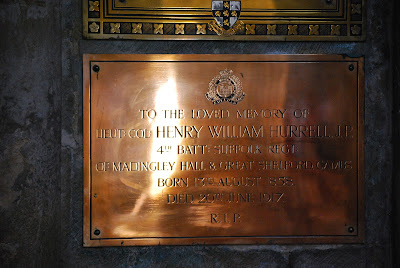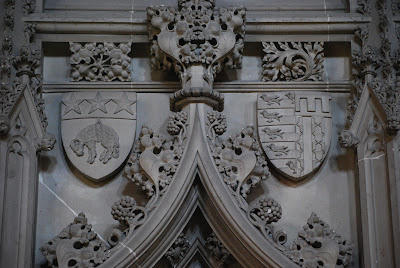One of the fun things about using heraldry is that, in addition to bearing your own coat of arms, you may, in appropriate places, also display what are called "arms of affiliation"; that is, the coats of arms of places and institutions with which you have been a part, or affiliated with in some significant way.
It is especially appropriate to point this out as we come to the memorial tomb of Bishop James Russell Woodford, Bishop of Ely 1873-1885.
Much of Bishop Woodford's biography here was taken from his entry in Wikipedia,
https://en.wikipedia.org/wiki/James_Woodford_(bishop).
James Russell Woodford (1820-1885) was an English churchman. He was the only son of James Russell Woodford, a hop-merchant in Southwark, and Frances, daughter of Robert Appleton of Henley (no relation to me). He was sent to Merchant Taylors' School at the age of eight, and was elected to Pembroke College, Cambridge, as Parkins exhibitioner in 1838. He graduated B.A. in 1842, and M.A. in 1845. He was ordained deacon in 1843 and priest in 1845, and in the intervening years held the second mastership of Bishop's College, Bristol. His first incumbency was the parish of St. Saviour's, Coalpit-heath, Bristol. He then worked as vicar of the parish of St. Mark's, Easton, in the same district, between 1847 and 1855, in which year was presented to the vicarage of Kempsford, Gloucestershire.
During the thirteen years he was at Kempsford he attracted attention as a preacher, and was made one of his examining chaplains by Bishop Samuel Wilberforce. Woodford became honorary canon of Christchurch, and in 1864 was a select preacher at Cambridge, He also acted as proctor for the clergy of his diocese in the Canterbury convocation, In 1868 Woodford was appointed vicar of Leeds. In 1869 he received a D.D. degree, and in 1872 was appointed one of the queen's chaplains. In the following year he succeeded Harold Browne as bishop of Ely, being consecrated in Westminster Abbey on December 14, 1873.
Above the recumbent figure of Bishop Woodford flanking the three Baroque arches over his memorial are six coats of arms which are not his, but which are "arms of affiliation"; that is, places and institutions which played a significant part of his life at one time or another, as you will see as we identify them one by one.
These six arms of affiliation are, from left to right:
The City of Leeds (
Azure a fleece or pendant from a chief sable charged with three mullets argent); and Pembroke College, Cambridge, which we have seen before in Cambridge, as well as the other Cambridge College arms further below (
Barry of ten argent and azure an orle of martlets gules (de Valence) dimidiating Gules three pales vair on a chief or a label of five points azure (de St. Pol));
The Worshipful Company of Merchant Taylors (
Argent a royal tent between two parliament robes gules lined ermine the tent garnished or, tent staff and pennant also or, on a chief azure a lion passant guardant or); and St. John’s College, Cambridge, (
Quarterly France modern and England, all within a bordure compony argent and azure (Beaufort));
Jesus College, Cambridge (
Argent on a fess between three cock’s heads sable combed and wattled gules a bishop’s mire or within a bordure gules semy of crowns or); and Peterhouse, Cambridge (
Or three pales gules on a bordure gules eight crowns or (a combination of the personal arms of Hugh de Balsham, Bishop of Ely, with a bordure representing the See of Ely, whose arms are
Gules three crowns or).
The whole memorial is quite complex, with roses and floriated decoration and curves and cutouts and all sorts of embellishments. But it was this use of arms of affiliation that really elevates this memorial above and beyond the usual, at least in my eyes.


















